Did you know that butterflies can boost garden pollination by up to 30%? If you’re looking to create a butterfly garden that’s also a peaceful retreat, start with a sunny spot getting 6-8 hours of light daily. Pick a 10×10-foot area, ideally near your home for easy access. There’s more to contemplate for blending beauty and calm, so stick around for the full plan.
Contents
Butterfly Garden Design
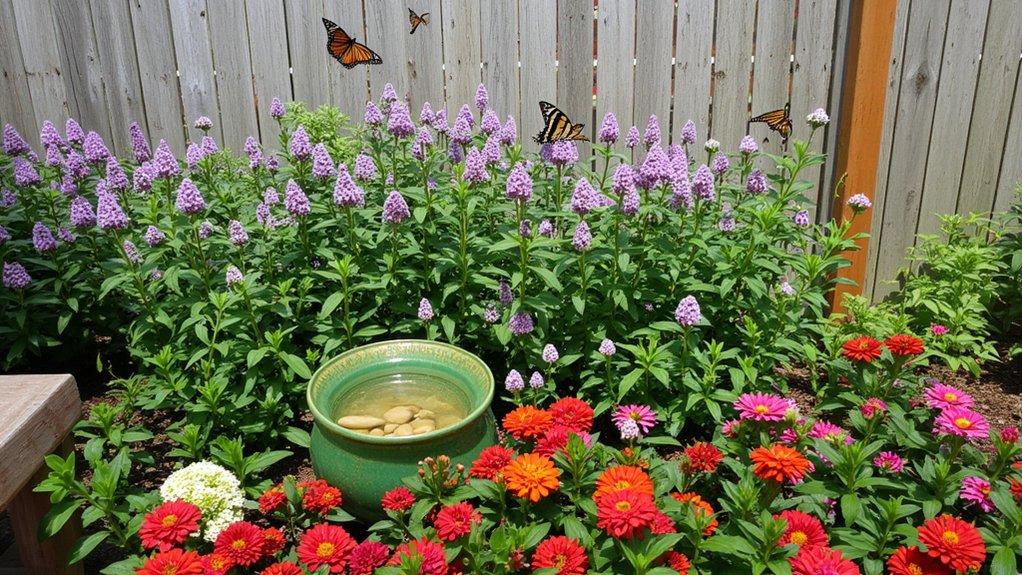
While planning your butterfly garden, start with a clear design to attract those winged beauties. Pick a sunny spot, ideally 6-8 hours of direct light daily, since butterflies thrive in warmth. Make sure it’s sheltered from strong winds, maybe near a fence or hedge.
Next, sketch a layout with a mix of heights and textures. Aim for a 10×10-foot area if space allows, ensuring room for various plants and a small resting spot for you. Group plants in clusters of 3-5 for better visibility to fluttering visitors.
Finally, add a shallow water source, like a saucer with pebbles, refilled every 2-3 days. Place it centrally, so butterflies can sip safely. Keep paths clear for easy access while you watch them dance by.
Colorful Nectar Plants
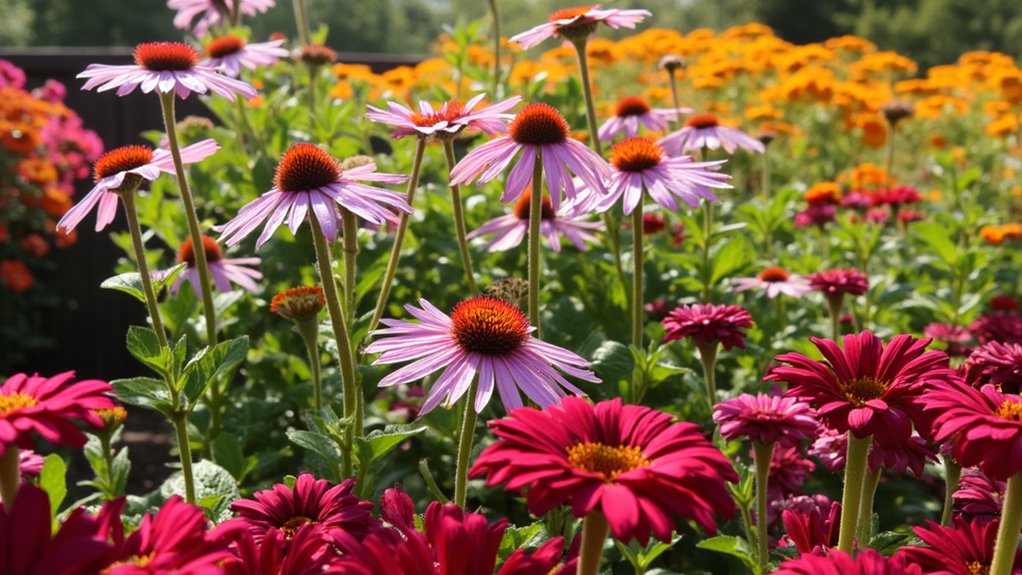
Hey there, let’s immerse ourselves in picking the right colorful nectar plants for your butterfly garden. You’ve gotta choose blooms that butterflies can’t resist, like vibrant zinnias, marigolds, and lantanas. These plants offer nectar, the sweet fuel butterflies need daily.
Start by planting in clusters, say, groups of 5-7 plants per variety, spaced about 12-18 inches apart. This makes it easy for butterflies to spot them from the air. Opt for full-sun spots, since most nectar plants thrive with 6-8 hours of sunlight.
Don’t forget variety in bloom times—mix early bloomers like coneflowers with late-season asters. Check local nurseries for native species; they’re often best adapted. Water them deeply, about 1 inch weekly, to keep those blooms popping for your winged visitors.
Shady Resting Spots
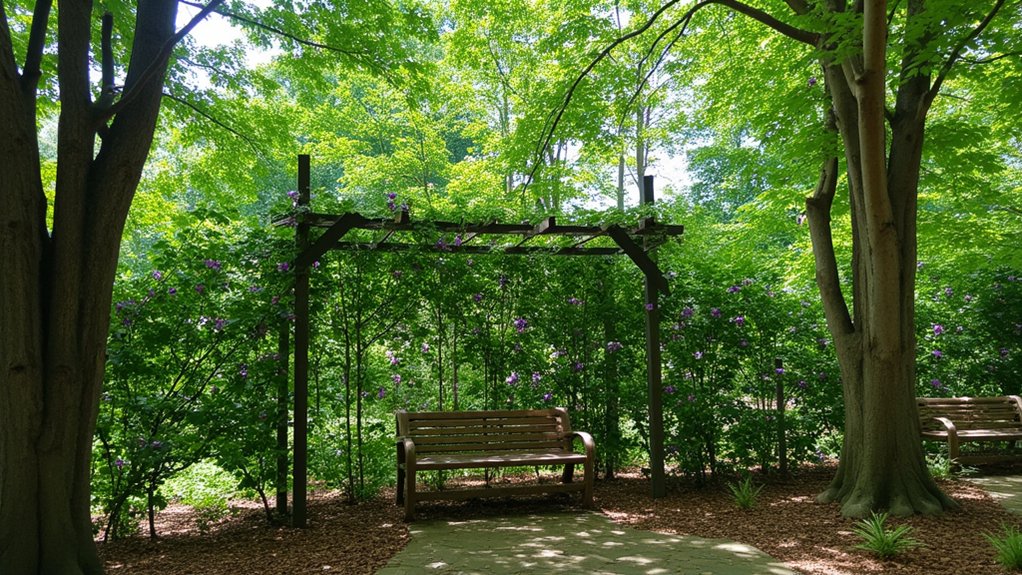
Let’s plunge into creating shady resting spots for your butterfly garden. You’ve got to give butterflies, and yourself, a cool place to unwind. Pick a corner, ideally 5-10 feet wide, where trees or tall shrubs can cast dappled shade.
Start by planting native trees like oaks or maples, spacing them 8-12 feet apart for growth. If you’re short on space, use a trellis, about 6 feet tall, with climbing vines like clematis for quick cover. Check growth weekly, trimming vines to maintain shape.
These spots aren’t just functional; they’re your mini escape. Place a simple bench, roughly 4 feet long, under the shade for a quiet nook. Keep it tidy, clearing fallen leaves daily, so it’s always inviting.
Water Feature Attraction
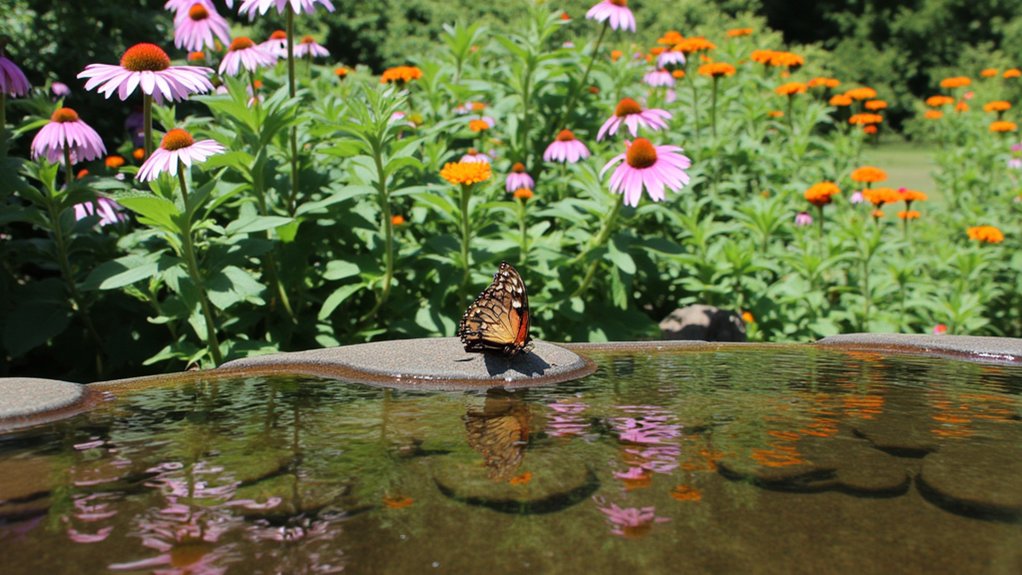
As you build your butterfly garden, consider adding a water feature to draw these delicate creatures in. Butterflies need shallow water for drinking, so you’ve gotta think small. A simple birdbath with a 1-2 inch depth works perfectly.
Now, place flat rocks in the water, letting tops peek out as landing spots. Add this feature near nectar plants, ideally within 10 feet, to keep butterflies close. Check the water daily, refilling to maintain that shallow level, since it evaporates fast.
Don’t use deep containers; butterflies can drown easily. Instead, refresh the setup weekly, scrubbing algae off rocks with a brush. Position it in partial sun, about 4-6 hours daily, so it’s inviting but not too hot for them.
Butterfly-Friendly Seating Area
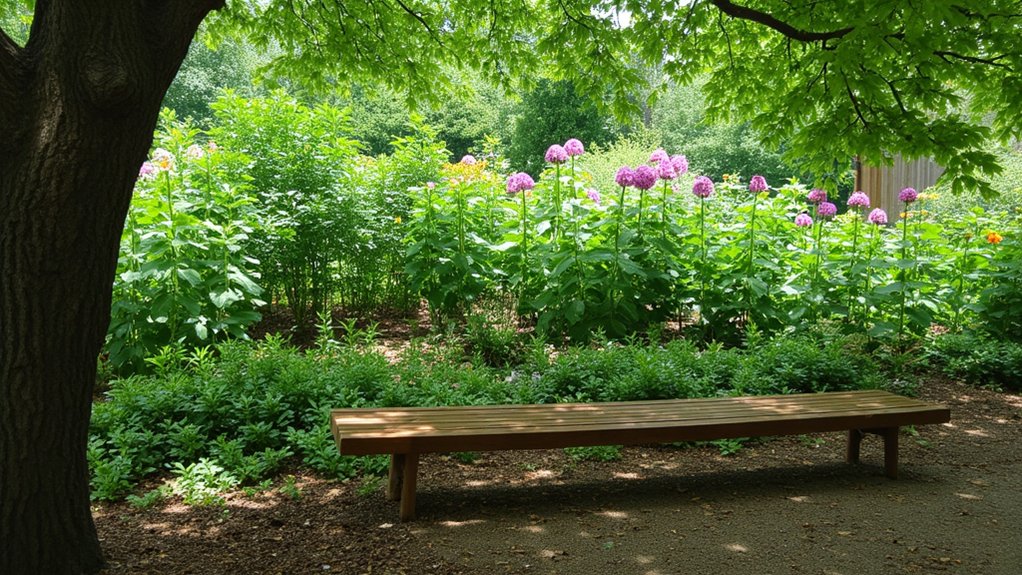
While planning your butterfly garden, don’t forget to carve out a comfy spot for yourself to enjoy the view. Pick a shaded area, ideally under a tree or near tall plants, for cooler seating. Make sure it’s at least 5 feet from the main butterfly activity to avoid disturbing them.
Set up a small bench or a pair of weather-resistant chairs, about 18-24 inches high for comfort. Position them facing the garden’s brightest flowers, so you’ve got the best view of fluttering wings. Add a tiny side table, roughly 2 feet wide, for a drink or book.
Check the spot weekly for debris or overgrowth, keeping it tidy. With this setup, you’ll relax while butterflies dance nearby.
Quiet Meditation Corner
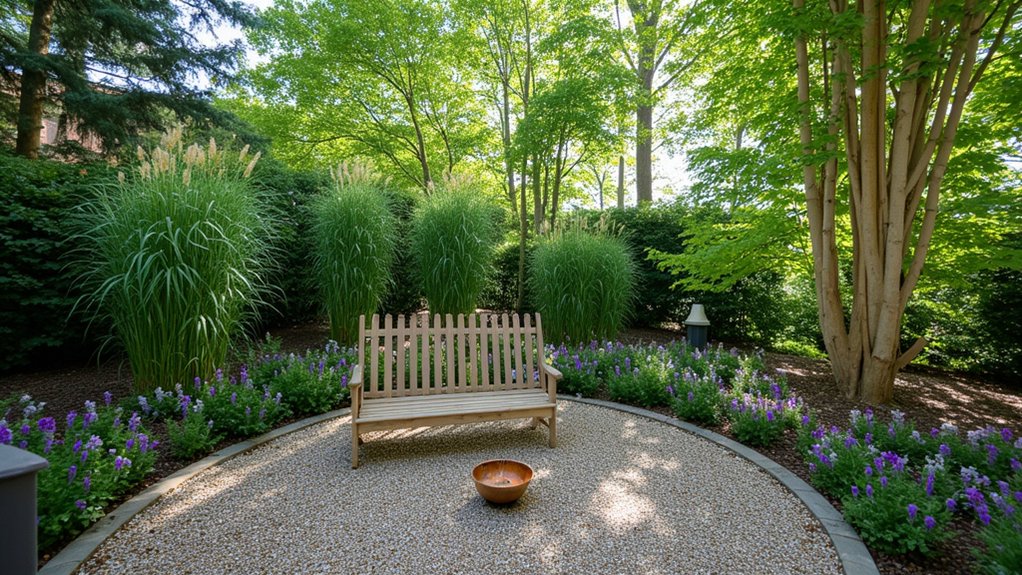
Beyond your butterfly-friendly seating, carve out a Quiet Meditation Corner for some peaceful reflection. Pick a tucked-away spot, maybe 5 by 5 feet, near a shady tree or fence. You’ll want privacy, so consider a low hedge or tall grasses as a natural screen.
Now, lay down a simple base—think gravel or flat stones, about 2 inches deep, for easy upkeep. Place a weatherproof cushion or small bench right in the center for sitting. Make sure it’s comfy for at least 20 minutes of quiet time.
Lastly, add a small water feature, like a 12-inch tabletop fountain, for a gentle trickle sound. Set it up in under an hour, plug it in, and you’re ready to unwind in your serene nook.
Soothing Aromatherapy Plants

Ready to boost the calm in your butterfly garden retreat? Let’s add soothing aromatherapy plants that’ll elevate your space. Scents can relax your mind, so pick the right ones.
Start with lavender, a classic for its calming aroma. Plant it in full sun, spacing plants 12-18 inches apart for good airflow. It blooms in summer, usually June to August, releasing a gentle fragrance.
Next, try chamomile, perfect for a subtle, apple-like scent. Sow seeds in early spring, about ¼ inch deep, in well-drained soil. It grows fast, often sprouting in 7-14 days, and you’ll enjoy its scent by mid-summer.
Finally, consider mint—easy to grow but keep it contained! Plant in pots, as it spreads quickly, and enjoy its invigorating vibe.
Natural Stone Pathways
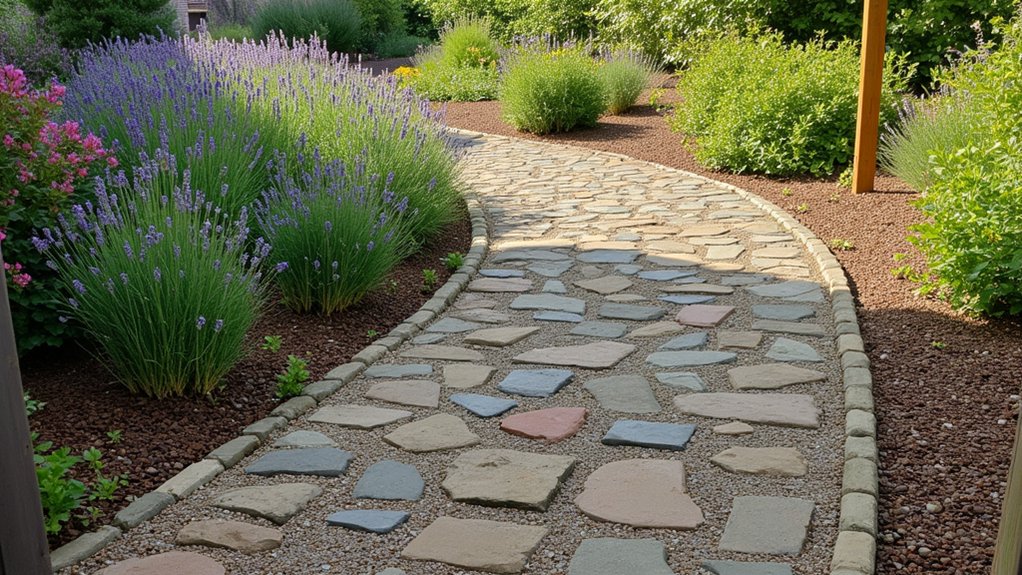
Let’s begin crafting natural stone pathways for your butterfly garden retreat. You’ll create a charming, winding trail that guides you through vibrant blooms. Start by mapping a 3-foot-wide path, using string or chalk for precision.
Next, dig out the path about 4 inches deep, removing grass and roots. Lay a 2-inch base of compacted gravel for stability, then arrange flat natural stones like slate or limestone, spacing them 1-2 inches apart for a rustic look. Fill gaps with fine pea gravel for a tidy finish.
Work on this over a weekend; it’s straightforward but takes muscle. Check stones are level with a carpenter’s tool, adjusting as needed. Soon, you’ve got a durable, butterfly-friendly walkway to enjoy for years.
Serene Butterfly Observation Bench
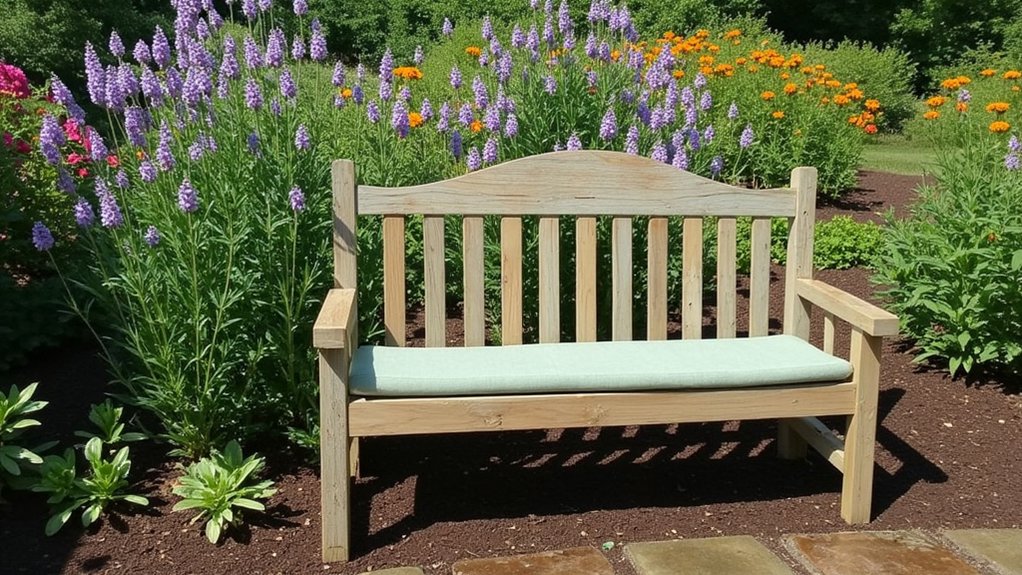
After crafting those natural stone pathways, it’s time to set up a cozy spot for watching butterflies. You’ve gotta have a place to relax, right? Pick a quiet corner of your garden, ideally near blooming flowers that attract those winged beauties.
Start by choosing a sturdy wooden bench, about 5 feet long, to fit two people comfortably. Place it on a level spot, 3-5 feet from the nearest plants, so you don’t disturb the butterflies. Secure it by digging small holes, roughly 6 inches deep, for the legs if it’s not already stable.
Finally, add a weather-resistant cushion for comfort during long observation sessions. Check it weekly for wear, and replace it every 6-12 months if needed. There you go, your perfect perch!
Calming Wind Chimes
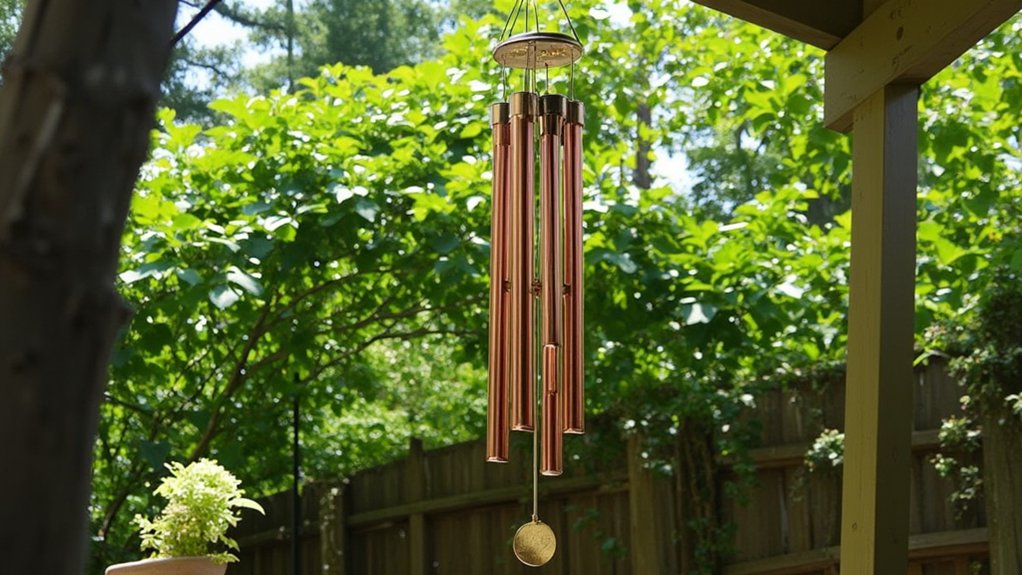
While you’re setting up your butterfly garden, don’t overlook the soothing addition of wind chimes. They’re an easy way to add a calming soundtrack, enhancing your retreat vibe. Pick chimes with soft, melodic tones—think bamboo or aluminum, about 20 to 30 inches long.
Hang them where breezes often blow, like near a tree branch or garden arch, about 6 feet off the ground. Use durable nylon cord, tying a secure knot, so they won’t crash on windy days. Place them 3 to 5 feet from seating areas for subtle sound, not annoyance.
Check them monthly for rust or wear, especially after storms. A quick wipe with a damp cloth keeps them looking sharp and sounding sweet.
